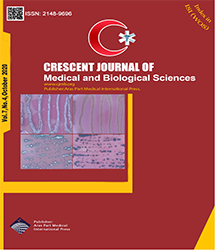| Original Article | |
| Identification and Antibacterial Activity of Actinomycetes Isolated From Medicinal Plant Andrographis paniculata Rhizosphere Soil | |
| Herlina Rante1, Gemini Alam2, Ermina Pakki3, Usmar Usmar4, Alimuddin Ali5 | |
| 1Laboratory of Microbiology, Faculty of Pharmacy, Hasanuddin University, Makassar, Indonesia 2Laboratory of Phytochemical, Faculty of Pharmacy, Hasanuddin University Makassar, Indonesia 3Laboratory of Pharmaceutical Technology Faculty of Pharmacy, Hasanuddin University, Makassar,Indonesia 4Laboratory of Pharmacology, Faculty of Pharmacy, Hasanuddin University, Makassar, Indonesia 5Departmen of Biology, Laboratory of Microbiology, Faculty of Mathematics and Science, Universitas Negeri, Makassar, Indonesia |
|
|
CJMB 2020; 7: 467-473 Viewed : 4147 times Downloaded : 3433 times. Keywords : Actinomycetes, Antibacterial, 16S rRNA gene, Andrographis paniculate, Rhizosphere |
|
| Full Text(PDF) | Related Articles | |
| Abstract | |
Objectives: Research related to the characterization of the secondary metabolites of actinomycetes rhizosphere medicinal plants, as well as the molecular identification of actinomycetes as an antibacterial compound producer was carried out on actinomycete isolates obtained from the rhizosphere soil of medicinal plants in South Sulawesi. The purpose of this study was to isolate actinomycetes from Andrographis paniculata rhizosphere and to determine their antibacterial activity against Escherichia coli and Staphylococcus aureus. Finally, actinomycetes that produce antibacterial compounds were identified as well. Materials and Methods: Two isolates of actinomycetes were obtained from A. paniculata named SM-4 and SM-6, which were fermented in the starch nitrate broth (SNB) medium for 14 days. The supernatant and biomass of the fermentation yield were separated, and then the supernatant was extracted using ethyl acetate. Next, the antibacterial activity test was conducted by the diffusion method using a paper-disk. Eventually, the identification of actinomycetes SM-4 and SM-6 was based on the sequence analysis of the 16S rRNA gene using universal primers 27f and 1492r. Results: The antibacterial activity of ethyl acetate extracts could inhibit the bacteria test to 2 mg concentration. Based on phylogenetic trees, actinomycetes SM-4 and actinomycetes SM-6 had the highest similarity with Streptomyces griseorubiginosus and Streptomyces phaeopurpureus, as well as Streptomyces purfeofuscus and Kitasatospora azatica, respectively. Conclusions: In general, actinomycetes SM-4 isolated from rhizosphere A. paniculata had the highest similarity with Streptomyces griseorubiginosus and Streptomyces phaeopurpureus with a similarity level of 97%. In addition, SM 6 isolated from the rhizosphere of A.s paniculata demonstrated the highest similarity with Streptomyces purfeofuscus and K. azatica with similarity levels of 97%. Finally, the thin layer chromatography-bioautography test revealed that the ethyl acetate extract from actinomycetes SM-4 had antibacterial activity at Rf 0.14 and 0.4 and was assumed to be a class of terpenoid compounds. |
Cite By, Google Scholar
Google Scholar
PubMed
Online Submission System
 CJMB ENDNOTE ® Style
CJMB ENDNOTE ® Style
 Tutorials
Tutorials
 Publication Charge
Medical and Biological Research Center
About Journal
Publication Charge
Medical and Biological Research Center
About Journal
Aras Part Medical International Press Editor-in-Chief
Arash Khaki
Deputy Editor
Zafer Akan


















